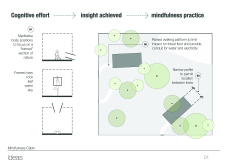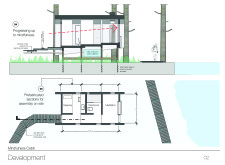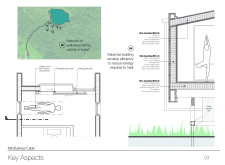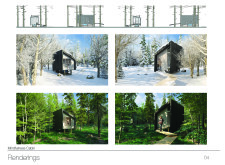5 key facts about this project
This architectural design emphasizes the importance of nature in facilitating mental clarity and emotional balance. By framing specific views of the environment through thoughtfully placed windows, the cabin invites users to engage with the natural world effectively. Each window acts as a lens, directing attention to various elements—be it the intricate shapes of the leaves, the gentle flow of nearby water, or expansive views of the sky—essentially encouraging occupants to immerse themselves fully in their surroundings.
The spatial organization of the cabin optimizes the flow of movement from one area to another, with careful attention to creating a journey toward mindfulness. Upon entering, visitors are greeted with an inviting atmosphere that subtly guides them through interconnected spaces, each designed to cultivate a sense of calm. The cabin includes essential areas such as a sleeping space, a washroom equipped with sustainable facilities, and a designated meditation room with expansive windows that allow light to pour in, enhancing the ambient experience.
The architectural design showcases a strong commitment to sustainability through its material selections. Notably, the cabin features a metal roof, which not only provides durability but also assists in efficient rainwater management. Cedar cladding adorns the walls, offering both aesthetic warmth and natural insulation that merges seamlessly with the forest. Prefabricated Structural Insulated Panels (SIPs) provide energy efficiency while minimizing the environmental impact during construction. Furthermore, the use of steel helical piles as a foundation method exemplifies the project’s intention to preserve the ecosystem, reducing excavation and site disturbance.
Unique design approaches are evident throughout the cabin. A network of elevated walkways connects multiple structures within the retreat, encouraging social interaction while maintaining a respectful distance from the forest floor. This careful arrangement minimizes the ecological footprint, ensuring that the natural habitat remains undisturbed. In addition, features such as skylights and retractable bug screens are integrated to maximize natural lighting and encourage users to enjoy fresh air without the annoyance of insects.
The overall aesthetic of the Mindfulness Cabin represents a blend of simplicity and adaptability, with spaces ranging from personal retreats to communal areas that foster connection and shared experiences. The project embodies a contemporary approach to architecture that not only prioritizes functionality but also seeks to enhance the emotional and spiritual well-being of its users through thoughtful design.
To gain a deeper understanding of the Mindfulness Cabin and its intricate design elements, readers are encouraged to explore detailed presentations that include architectural plans, sections, and ideas. This exploration will provide further insight into how the project's thoughtful architecture promotes a unique experience centered around mindfulness in nature.


























